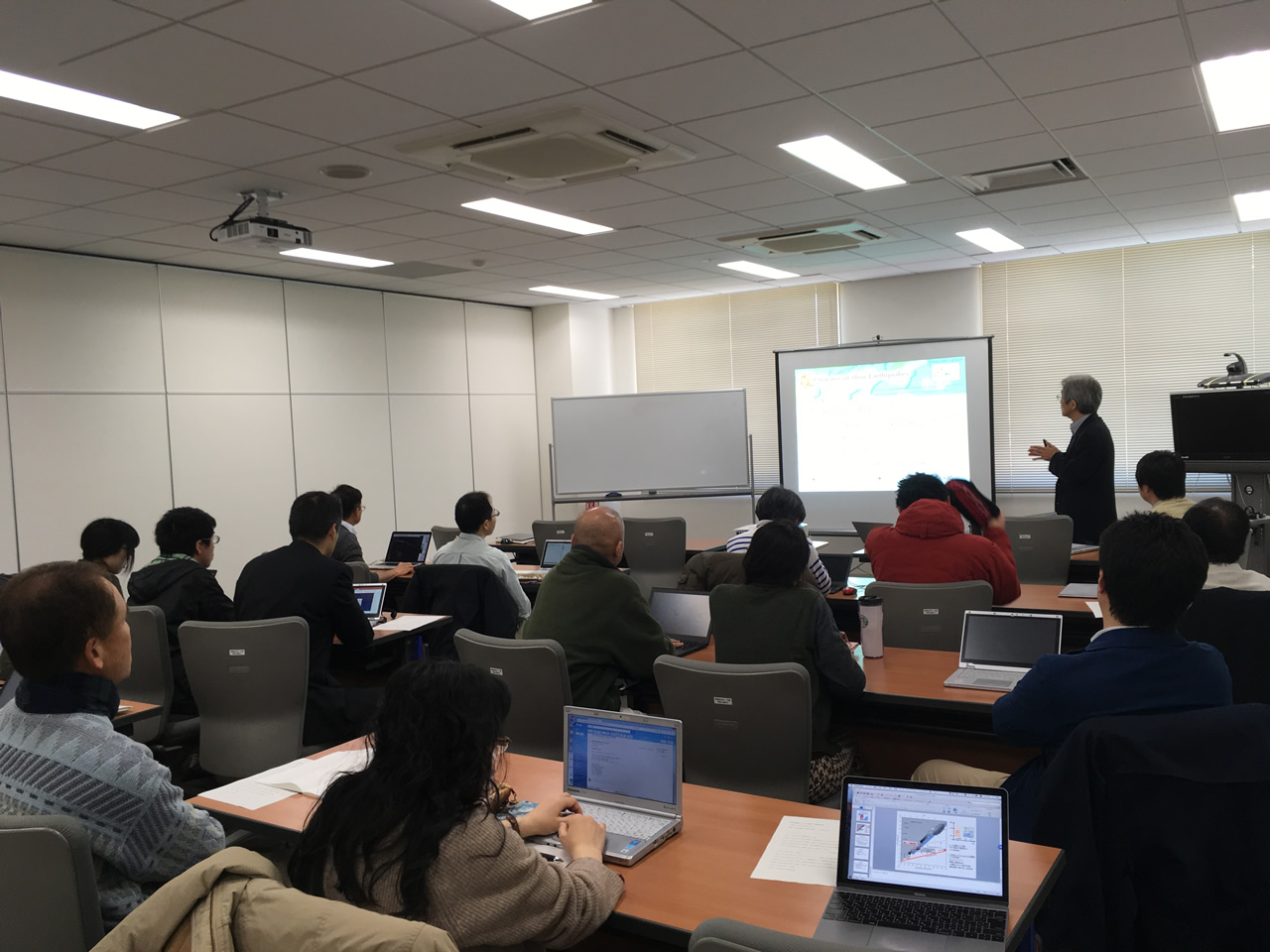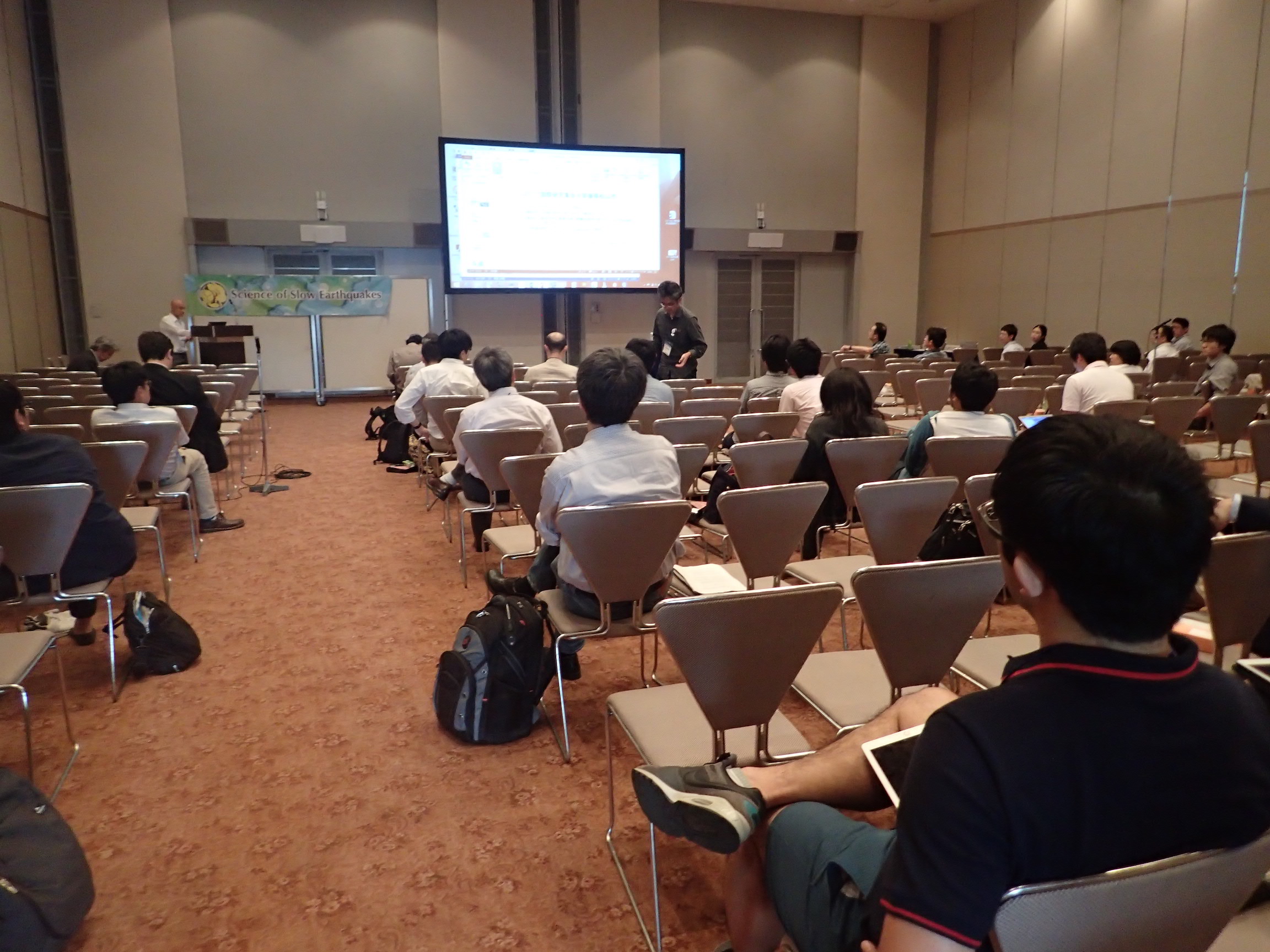Events / Activities2017
Dec. 11-15, 2017
Related session at AGU FALL MEETING 2017
Sep.19-21, 2017
Information updated for the Joint Workshop on Slow Earthquakes 2017 in Matsuyama city, Ehime prefecture
| Date | 2017/9/19-21 |
|---|---|
| Venue | (formerly "Hotel JAL City Matsuyama") |
Details | Planned schedule Sep. 19 (Tue.) 9:00 - Sep. 21 (Thu.) 15:00 Field trip (Sep. 22-23, Sambagawa, central Shikoku) Workshop site |
Another reason why we decided to hold the workshop in Matsuyama is the JGS 2017 was planned at the Ehime University, Matsuyama city right before our workshop.
Unfortunately, the session on slow earthquakes at the JGS 2017 and the lecture for the public jointly planned on September 17th with the MEXT Grant-in-Aid for Scientific Research on Innovative Areas "Interaction and Coevolution of the Core and Mantle" were both cancelled due to the typhoon.
Our workshop was held as planned with 130 participants including 18 researchers from overseas. There were 43 oral and 60 poster presentations on wide diversity of studies such as seismology, geodesy, geophysics, geology, nonlinear physics, mathematical statistics. That shows that we need many different approaches from various point of views to understand slow earthquakes.
As I mentioned at the closing remarks, when I first found a deep low frequency tremor, a strange vibration similar to a tremor was monitored in the Tokai area. I assumed it was vibration due to a mud volcano eruption looking at the location of estimated hypocenter and surrounding geological environment.
The presentation on relationship between mud volcanoes at the workshop and slow earthquakes shows a new approach to slow earthquakes as well as reminded me of that finding 20 years ago.
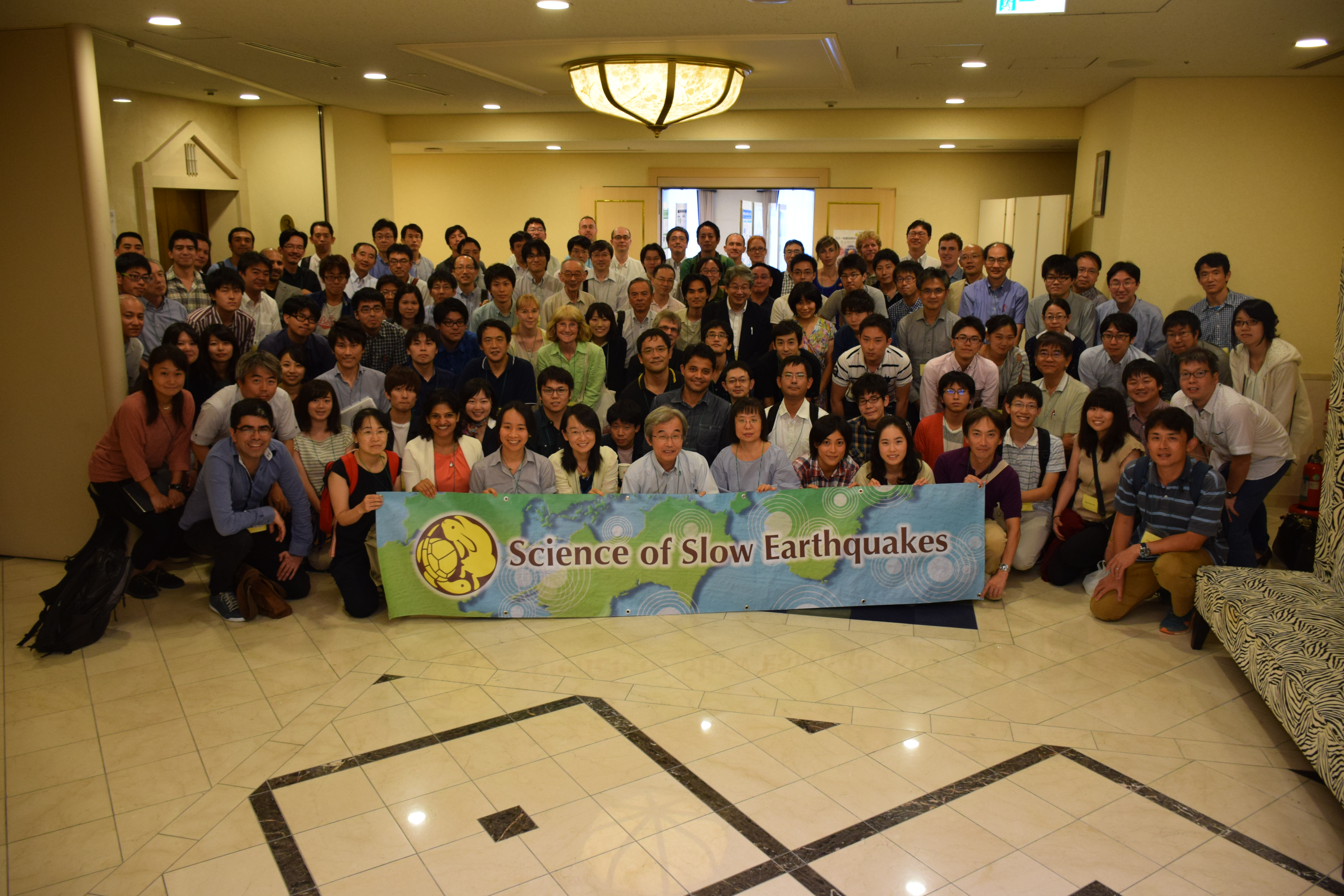
After the joint workshop in Matsuyama city, Ehime prefecture, some participants took part in the field trip to Sanbagawa Belt guided by Professor Wallis of Nagoya University, a co-investigator in Group B02. We observed metamorphic rocks along the Asemigawa river in Kochi prefecture on Day 1 and along the Kokuryogawa river in Ehime prefecture on Day 2. Total of 20 participants included researchers and students both from Japan and overseas with a wide variety of research fields such as geology, non-linear physics, seismology and mathematical statistics. For those who are not geologists, it was exciting to see the hydration and dehydration process in the subduction zone. Active discussions took place on the reaction speed and fluid migration velocity. Colors of metamorphic rocks vary depending on what they were formed from. The findings from the field trip would accelerate multidisciplinary discussions on interactions between rocks and fluids in source areas of slow earthquakes. (Akiko TAKEO, Group A01)
From the partticipants
The purpose of the slow earthquake fieldtrip was to observe structures that are likely to be related to slow earthquake formation in the Sanbagawa paleosubduction zone. Many of the talks during the slow earthquake workshop had focused on indirect observations of the subduction zone theorizing the different possibilities that might cause slow earthquakes. A few key concepts that stuck to my mind from the talks given during the conference were the role of coupling in the subduction zone and the role of fluid consuming and releasing mineral reactions. Looking at the Sanbagawa rocks we had a tangible chance to peer into the actual geology of a paleosubduction zone. The interplay of brittle and ductile deformation was something I tended to pay attention to, as this was a major point that the concluding talk of Ake Fagereng had focused on. On the first day we explored three locations in Asemigawa. The first outcrop, known as Kameiwa, is made up of folded siliceous and pelitic schists (Fig. 1). Many peoples interest was focused on the quartz veining cutting though the foliation as this can be seen as a sign of brittle fracturing in the subduction zone as well as a pathway for fluid flow. At the second locations we could see foliated mafic schists and quartz schist as well as structures resembling metamorphosed pillow lavas. Quartz veins were observed also at this location but folding was less pronounced.
The last location of the day was a river ravine with blocks of sedimentary/volcanic breccia (Fig. 2). These rocks were actually part of the Mikabu belt but had been overprinted by the Sanbagawa metamorphisim. Large rounded oblong clasts were oriented in the same directing showing ductile deformation of the matrix. The clasts themselves displayed brittle fracturing that was often filled by calcite. The day was topped with a lovely Japanese style dinner with many interesting dinner conversations!
The second day we headed to Kokuryogawa. The rocks seen on this day were higher metamorphic grade representing an area deeper in the subduction zone. At the first outcrop we looked at a metapelite that is located close to the Median Tectonic line showing structures that display brittle and ductile deformation. Figure 3 shows several normal faults that are bounded by a common layer in the metapelite in the bottom and marble vein on the top. It looks as though that during this deformation event the metapelites faulted in a brittle manner and the marble vein deformed in a ductile manner.
The second location of the day was the Tonaru metagabbro. These rocks represent the highest metamorphic grade found in the Sanbagawa belt. Here we could see amphibolite and zoisite rich layered rocks that are metamorphosed from a gabbroic protolith. These older gabbroic rocks spent a long time in the subduction zone being heated up. Large slowly growing garnet crystals, which were largely replaced by amphibole pseudomorphs, provide evidence for this. The final stop of the field trip was the Minetopia mine museum and the adjacent serpentinite rocks (Fig. 4). The serpentinites are of special interest in the Sanbagawa belt because they are though to be from the mantle wedge. The area of mantle wedge is especially interesting to slow earthquake research because this is where we can observe deep episodic tremor and slip. Serpentinite is a hydrated from mantle peridotite and mineral reactions in this region have a big impact on the fluid budget of the deep subduction zone. Examples of mineral such reactions can be seen also at this outcrop where serpentinite is chloritized.
Many thanks to Professor Wallis for guiding and organizing the trip and big thanks also for the organizers of the Slow Earthquake Workshop! (Ilona Sakaguchi, Nagoya University)
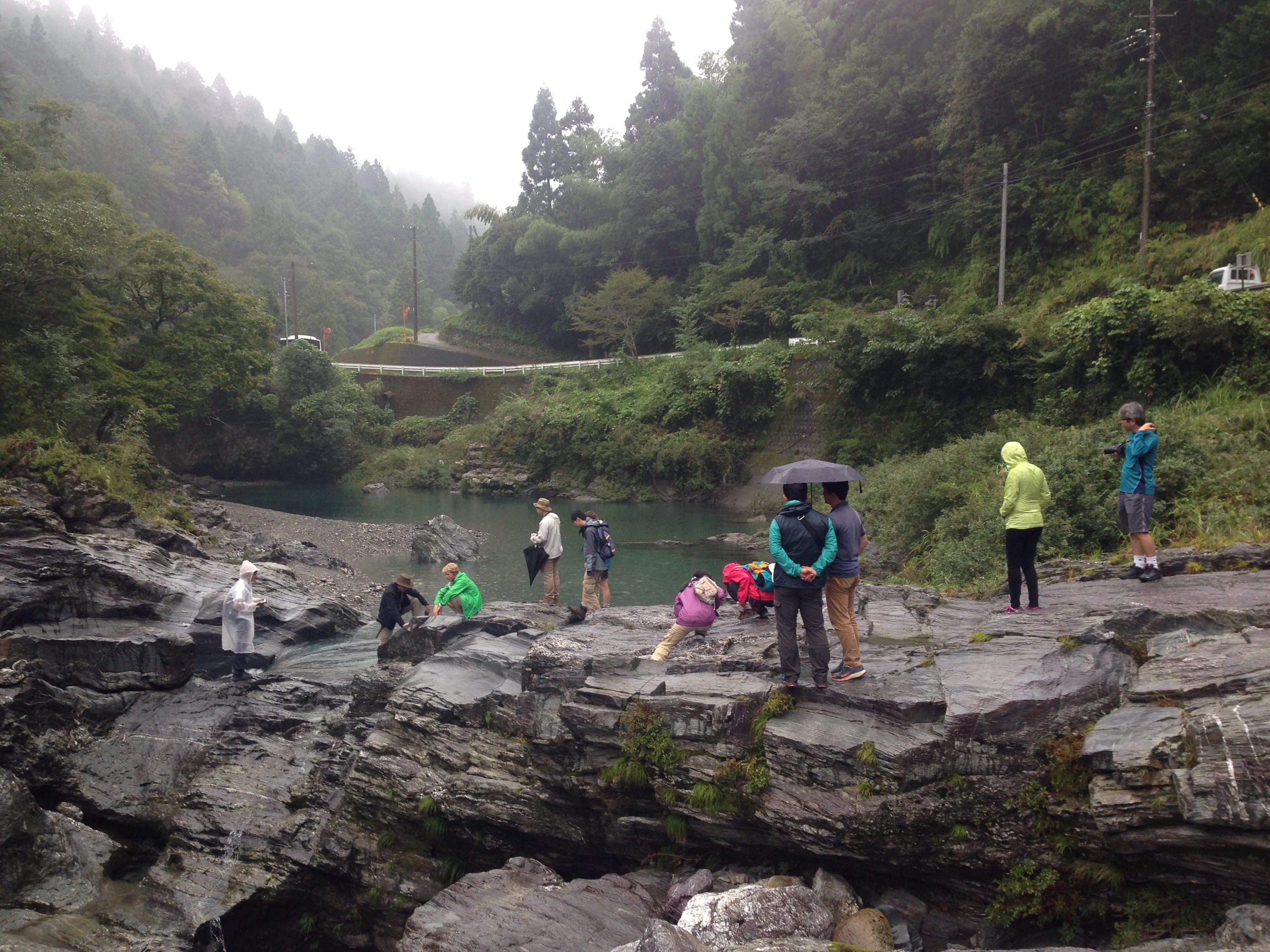
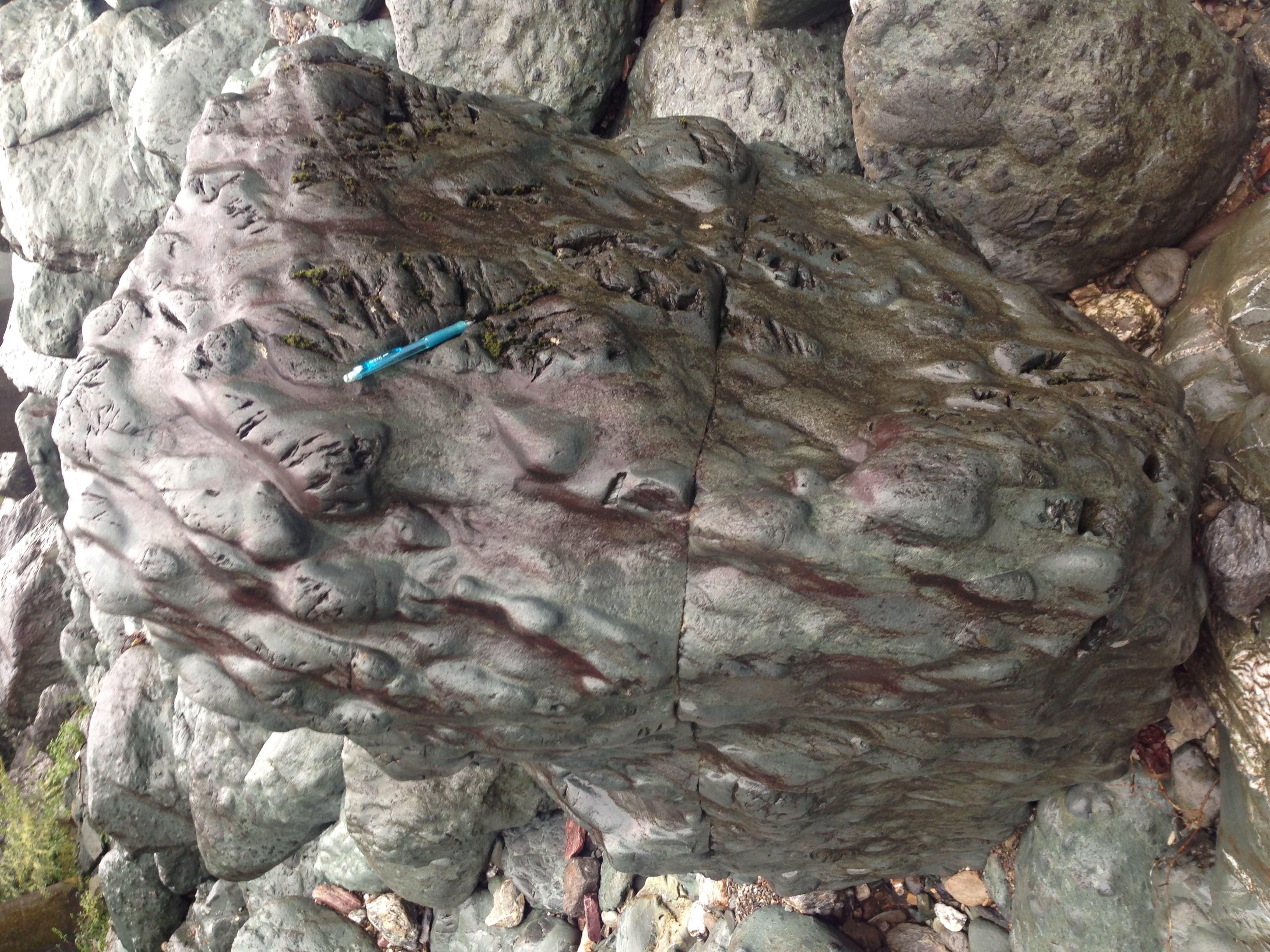
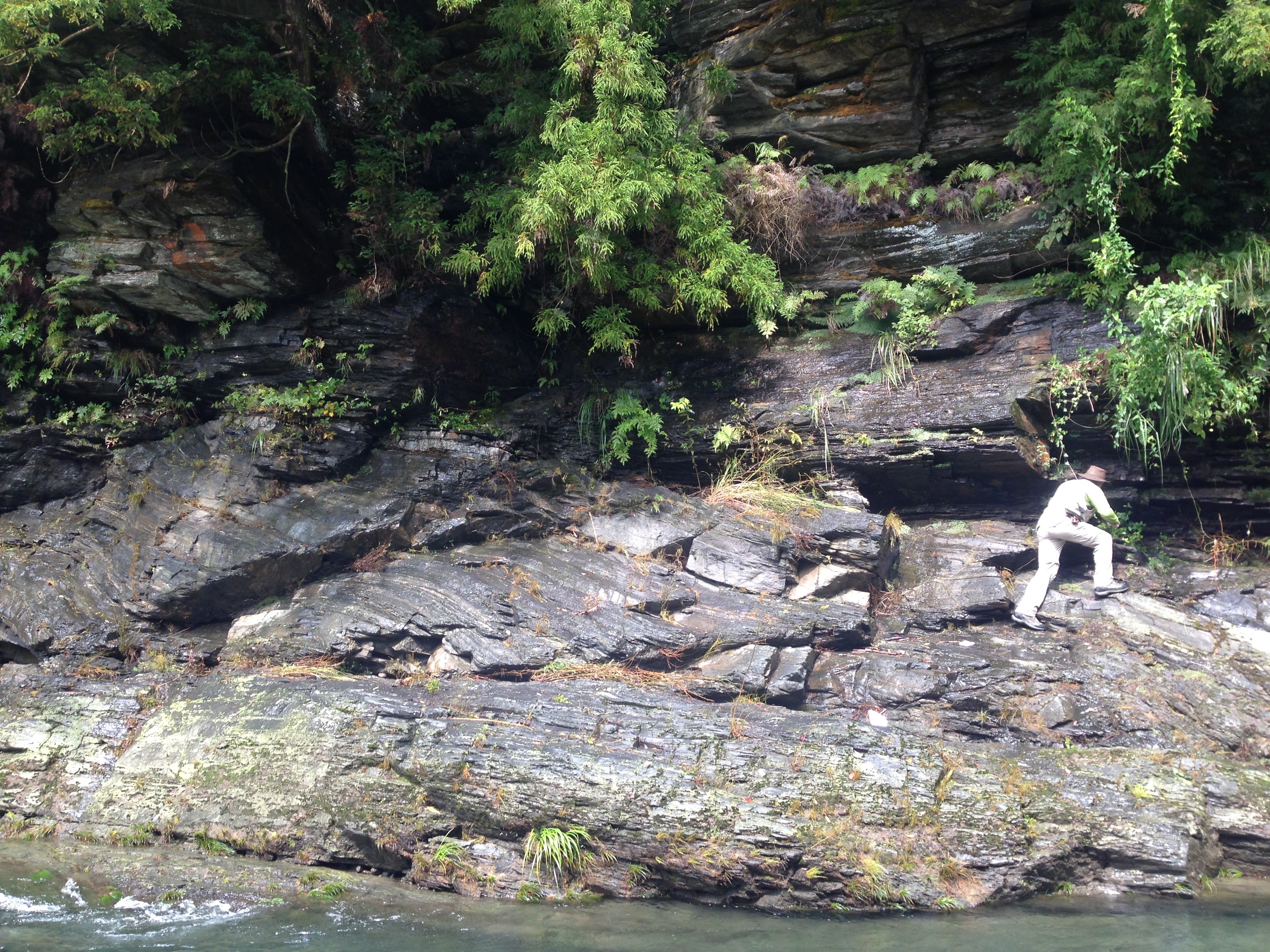
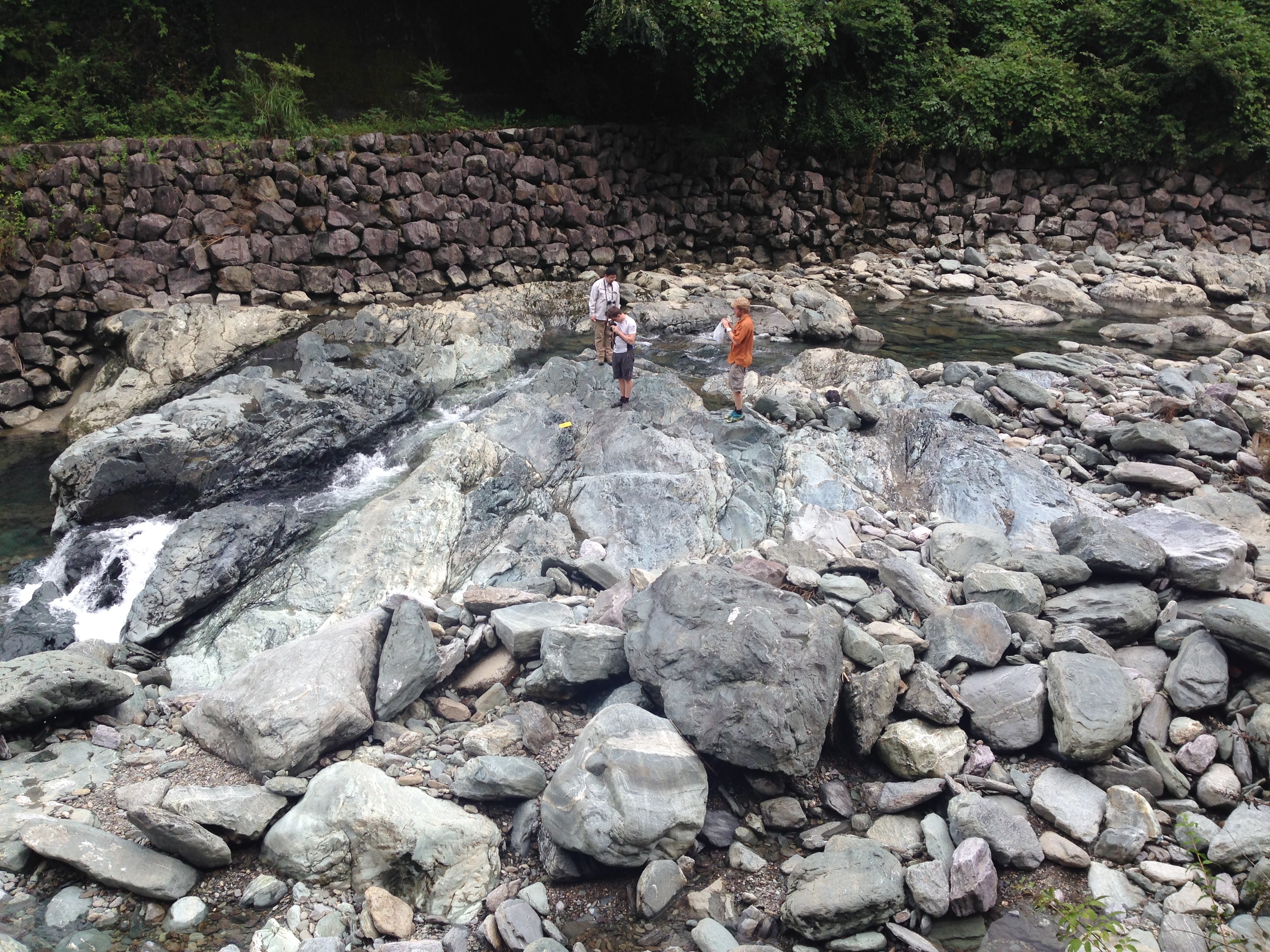
We visited many parts of the Sanbagawa Belt, one of the paired metamorphic belts in Shikoku island, located at the south of the Median Tectonic Line. The Sanbagawa Belt consists of rocks that are metamorphosed under high pressure and low temperatures in comparison to the adjacent belt, the Ryoke---Abukuma Belt, with high pressure and high temperature metamorphic rocks. On the first day, we visited Kameiwa and pillow lavas, and on the second day we stopped at three nteresting sites. One of them was Kokuryogawa with normal fault duplex, followed by Tonaru Metagabbro with rocks containing beautiful garnet crystals, and finally we visited an exposed outcrop of the mantle wedge with Serpentine rocks. (Deepa Mele Veedu, Nanyang Technological University)
The field trip to Sanbagawa belt was well-organized and a very interesting complement to the Joint Workshop on Slow Earthquakes in Matsuyama. Simon Wallis brought us to the most representative outcrops to illustrate the main geological features of the Sanbagawa metamorphic belt and explained detailed features of the rocks and how the metamorphic conditions can be determined by the structure and mineral componentry of the rocks. My main research field is developing statistical models to capture distinct features of seismic data. Metamorphism and seismicity belong to the same continuum of tectonic processes, and hence this trip was great to visualize the link between the ancillary data that I study and the geological processes that are their fundamental cause. (Ting Wang, University of Otago)
Sep.16-18, 2017
Related session at the 124th Annual Meeting of the Geological Society of Japan: 2017 Ehime
| Meeting | The 124th Annual Meeting of the Geological Society of Japan: 2017 Ehime (Official website) |
|---|---|
| Date | 2017/9/16-18 |
| Venue | Ehime University Johoku Campus |
| Details | Slow Earthquakes related session: T7. Geology of Slow Earthquakes |
September 15, 2017
Friday Seminar by Dr. Abhijit Ghosh
| Time/Date | 16:00-17:00, September 15, 2017 |
|---|---|
| Venue | Conference room #1, 5th floor, Building 2, ERI: Access Map |
| Speaker | Dr. Abhijit Ghosh (University of California, Riverside) |
| Topic | "Global observation of a wide spectrum of earthquakes" |
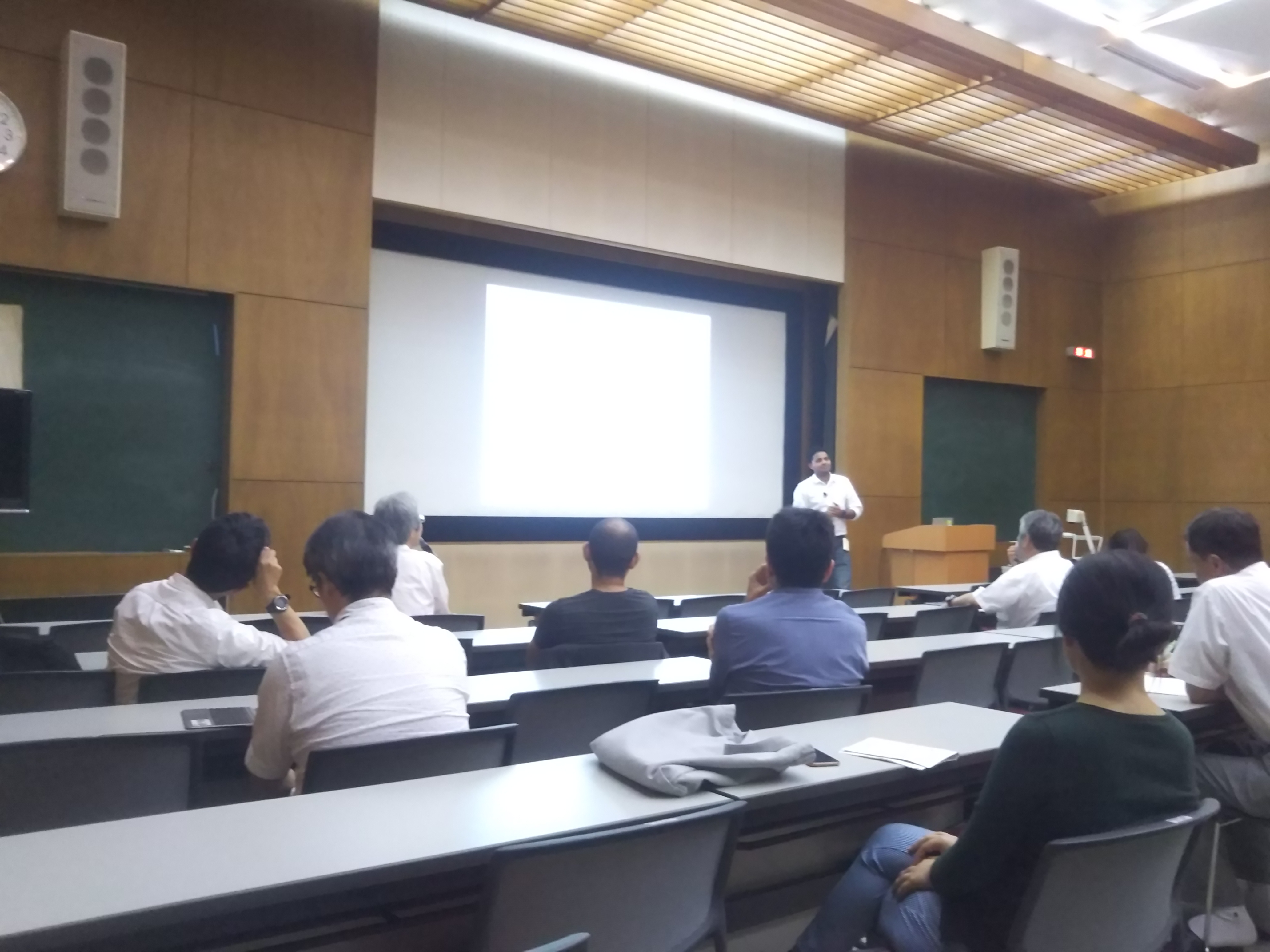
Jul.30-Aug.07, 2017
Related session at IAG-IASPEI 2017
| Meeting | IAG-IASPEI 2017 (Official website) |
|---|---|
| Date | 2017/7/30-8/7 |
| Venue | Kobe International Conference Center |
| Details | Slow Earthquakes related session: J06 The spectrum of fault-zone deformation processes (from slow slip to earthquake) Convener : Hitoshi Hirose (Kobe University, Japan) Co-convener : Yoshihiro Ito (Kyoto University, Japan), Chris Marone (Pennsylvania State University, USA) |
July 29, 2017
Slow Earthquakes Cafe in Kobe
We will hold the first Slow Earthquakes Cafe in Kansai area at Kobe University.
Please join us for a talk by Dr. Chris Marone before IAG-IASPEI 2017.
| Time/Date | 14:00-16:00, July 29, 2017 |
|---|---|
| Venue | Room #103, Building Z, Faculty of Science, Kobe University: Access Map |
| Speaker | Dr. Chris Marone (Pennsylvania State University) |
| Topic | "The Spectrum of Fault Slip Behaviors and The Mechanics of Slow Earthquakes: A View From The Laboratory" |
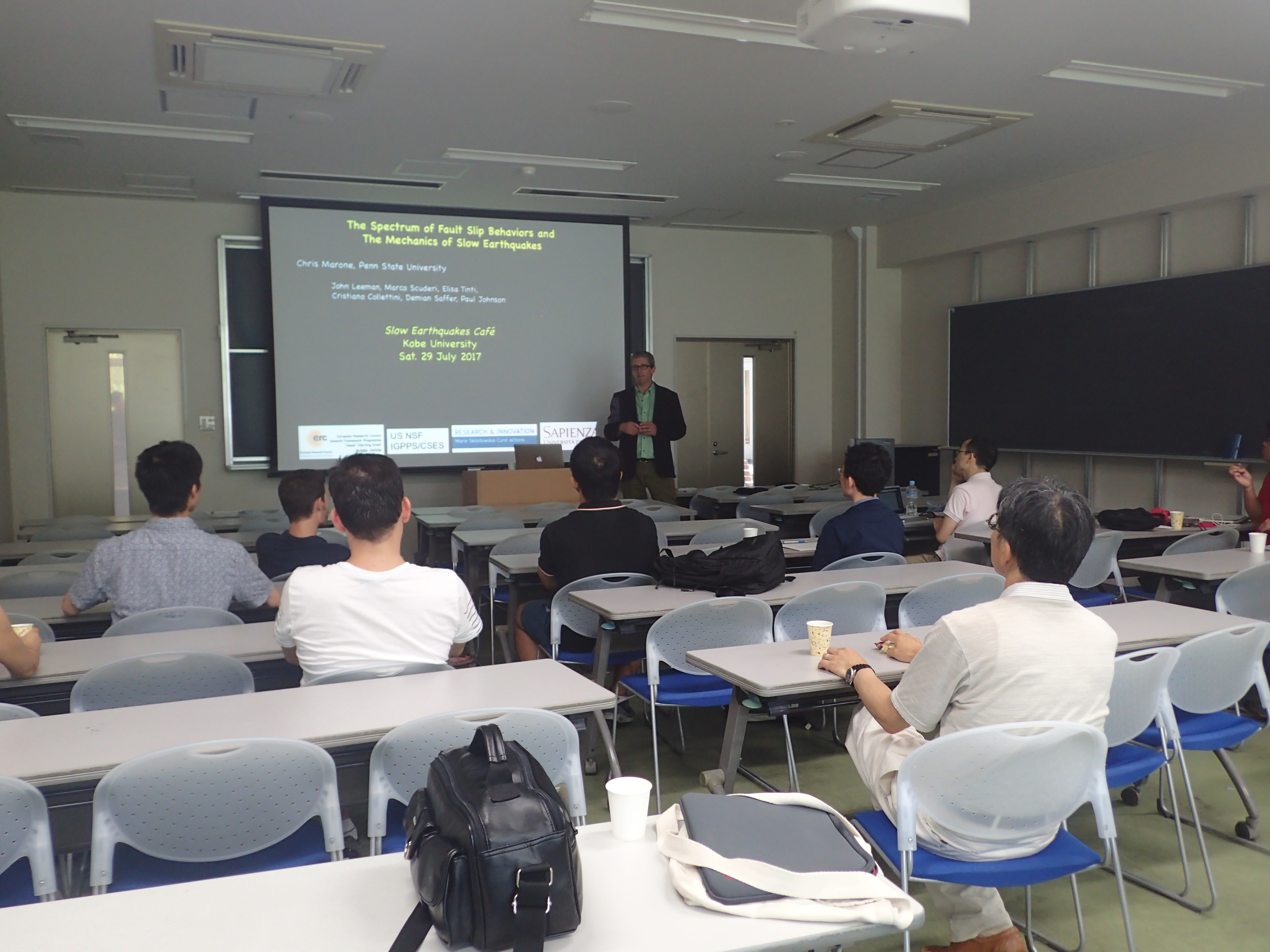
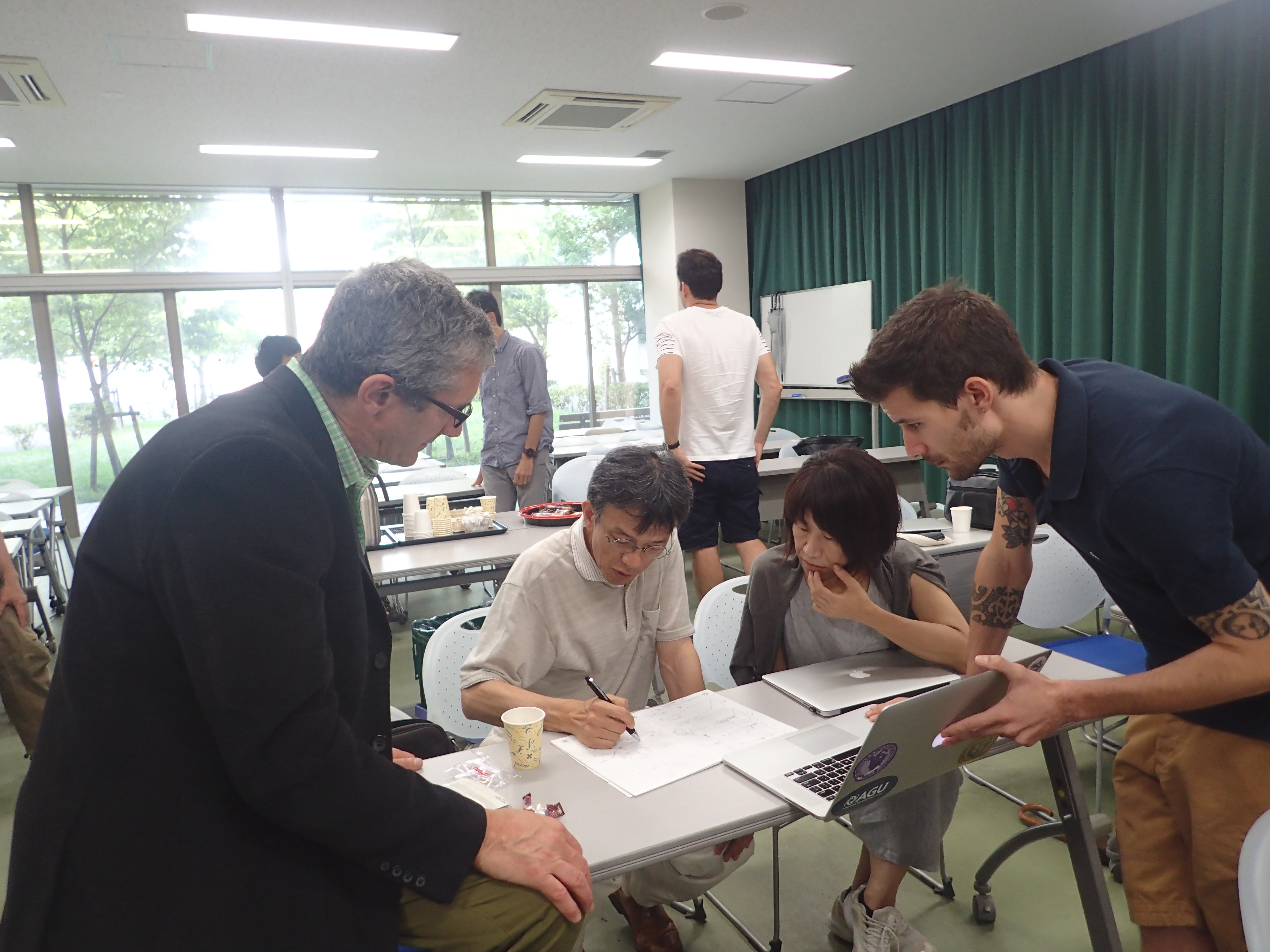
July 21, 2017
Dr. John Vidale and Dr. Heidi Houston visited Dr. Obara, the project leader of "Science of Slow Earthquakes."
Dr. John Vidale and Dr. Heidi Houston at the University of Washington dropped by the ERI to see Dr. Obara, the project leader of Science of Slow Earthquakes after an international workshop held at Misasa town, Tottori prefecture. They are globally notable seismologists who also have many achievements on slow earthquakes and have been working together with Dr. Obara. Dr. Kevin Chao, who gave a talk at the Slow Earthquakes Cafe on the previous day, also came by to see them. The latest research on slow earthquakes such as triggered tremors was discussed in Dr. Obara's office. Dr. Vidale is to be a new director at the Southern California Earthquake Center (SCEC) soon.
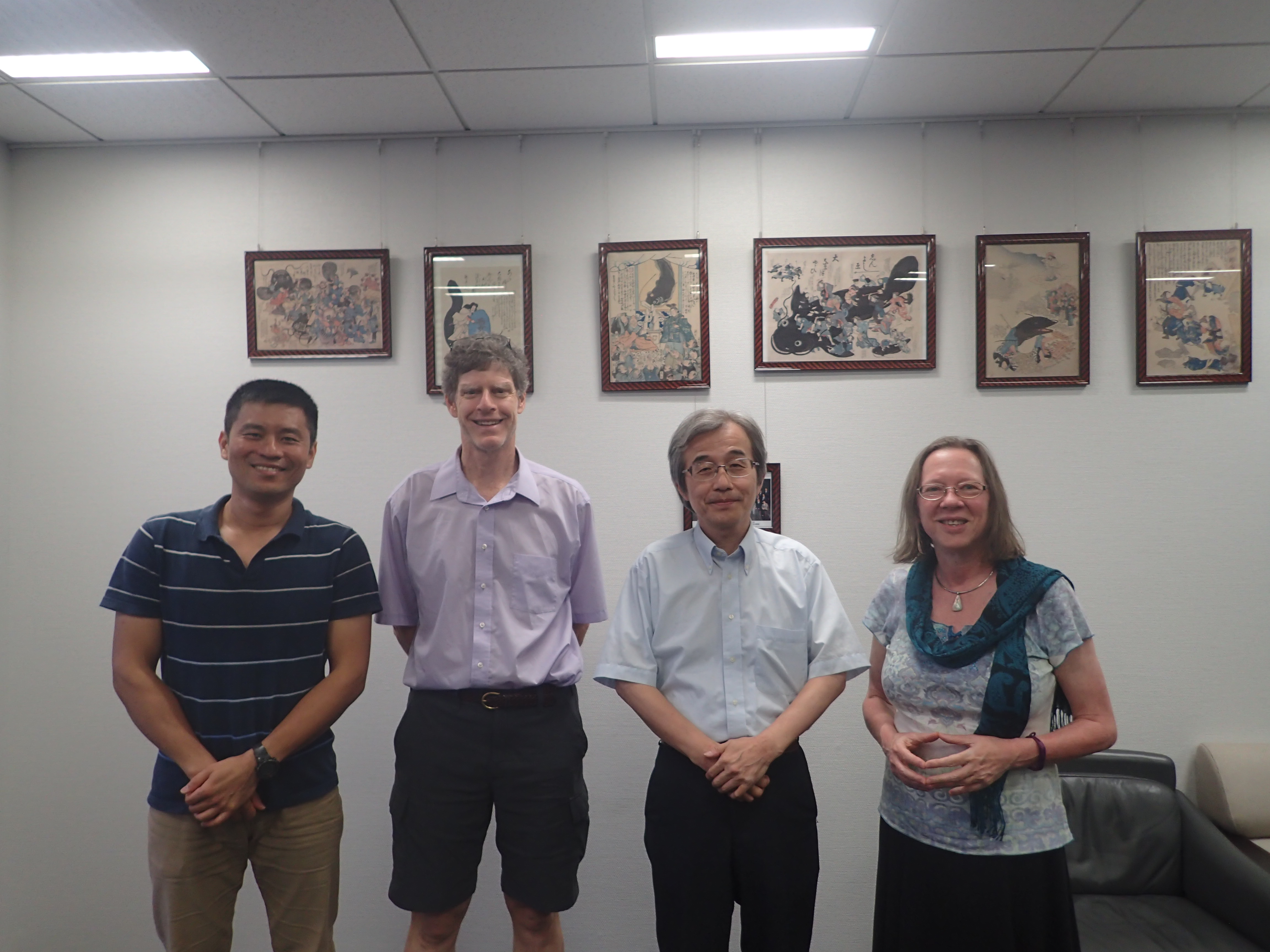
July 20, 2017
Slow Earthquakes Cafe
Please join us for the talk about slow earthquakes with soft drinks and snacks.
The meeting rooms will be open at 16:00. Please enjoy conversation with the speaker over a cup of coffee before the talk.
| Time/Date | 16:30-18:00, July 20, 2017 (16:00-16:30 Free talk with the speaker) |
|---|---|
| Venue | Meeting room A&B, 3rd floor, Building 1, ERI: Access Map |
| Speaker | Dr. Kevin Chao (Northwestern University) |
| Topic | "Dynamic Triggering of Tectonic Tremor: What are the similarities and differences between triggered and ambient tremor?" |
On July 20, we invited Dr. Kevin Chao of Northwestern University, U.S.A. as the speaker at the Slow Earthquakes Cafe and Bar.
Dr. Chao is from Taiwan. He stayed at the ERI as a postdoctoral researcher for 2 years after he received his Ph. D from Georgia Institute of Technology.
At the ERI, he conducted a joint research with Dr. Obara, the project leader of slow earthquakes, on deep low frequency tremors occurring at various locations in Japan. After staying at the ERI, he spent few years at MIT then now belongs to Northwestern University.
Dr. Kevin Chao is the world's leading researcher in the field of tremors triggered by remote seismic surface waves. At the cafe, he gave a talk on general explanation about tremors, world distribution of triggered tremors and the mechanism.
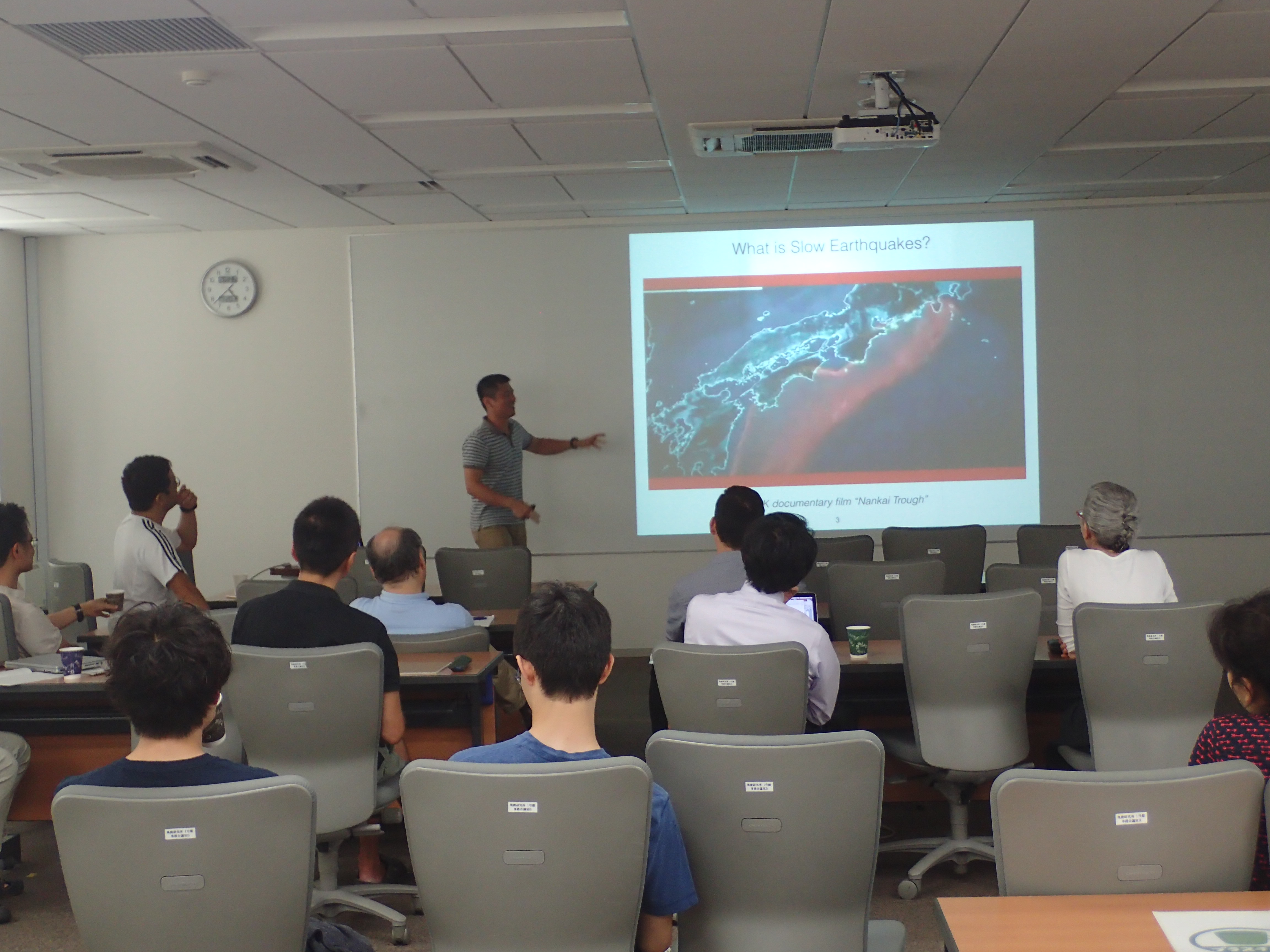
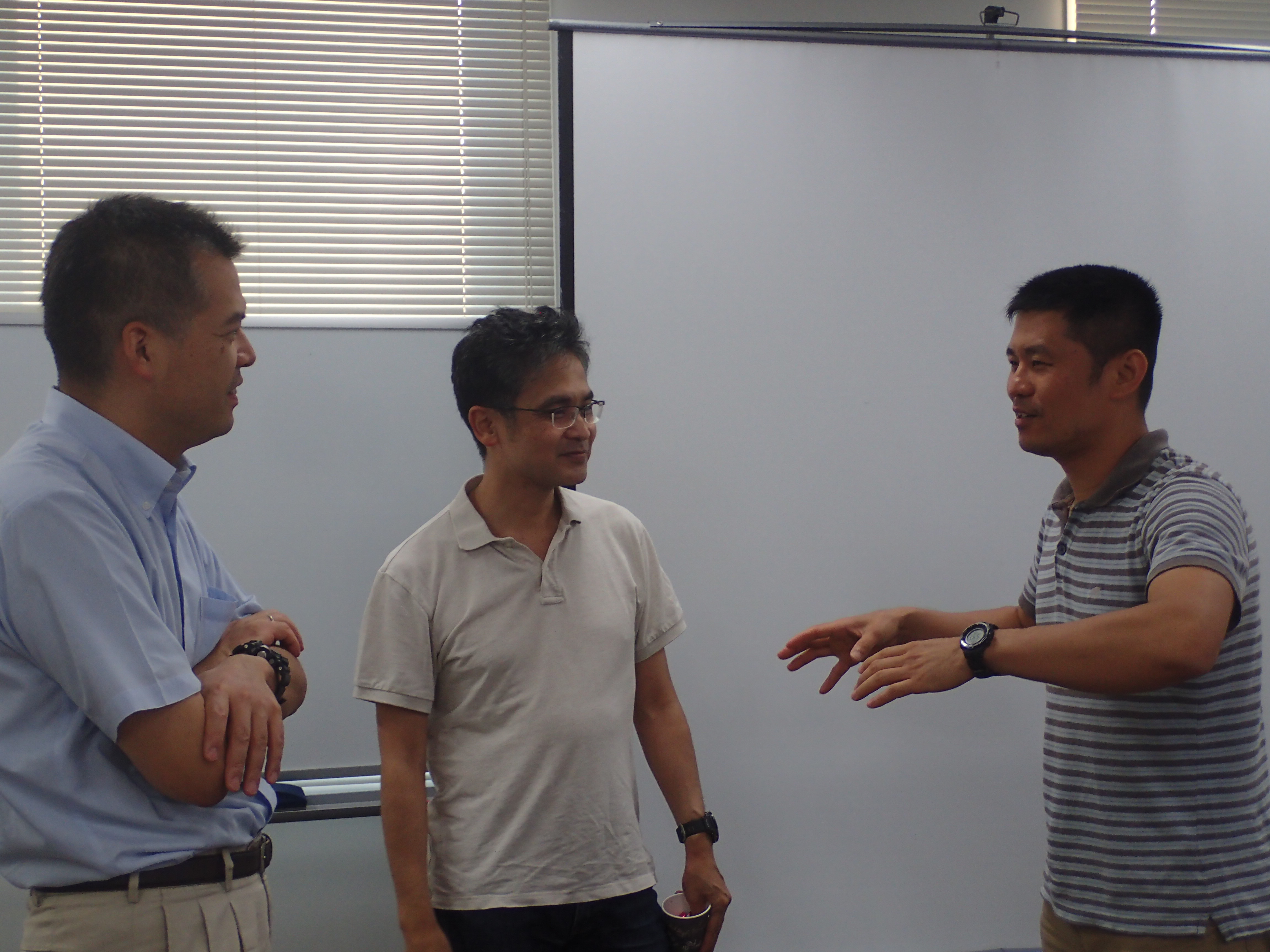
July 20, 2017
Seminar by Dr. Osbanny Ramos
| Time/Date | 11:00-12:00, July 20, 2017 |
|---|---|
| Venue | Meeting room #2, 2nd floor, Building 2, ERI: Access Map |
| Speaker | Dr. Osbanny Ramos (University of Lyon) |
| Topic | "Modelling Earthquakes with a Granular Experiment" |
May 20-25, 2017
Related session at JpGU-AGU Joint Meeting 2017
| Meeting | JpGU-AGU Joint Meeting 2017 (Official website) |
|---|---|
| Date | 2017/5/20-25 |
| Venue | Makuhari Messe |
| Details | Slow Earthquakes-related sessions: S-SS04: Subduction zone dynamics from regular earthquakes through slow earthquakes to creep Oral sessions: 5/24 (Wed.),25 (Thu.) 9:00-15:15 at A10 Link to the program Poster core time: 5/25 (Thu.) 15:30-18:30 at Poster Hall |
At JpGU-AGU 2017 we co-hosted the session " Subduction zone dynamics from regular earthquakes through slow earthquakes to creep." On May 24th and 25th, 24 oral presentations, including the ones by overseas invited speakers (Jessica Hawthorne, Lisa McNeill, Donna Shillington, Matt Ikari, William Frank, Eric Dunham and Onno Oncken, were given. Since it was the first joint meeting with AGU, there are lots of international visitors and we had fruitful presentations and discussions in English. Holding 65 poster presentations, we were the largest scientific session in the meeting. We hope active discussions on the meeting may lead new achievements on the study.
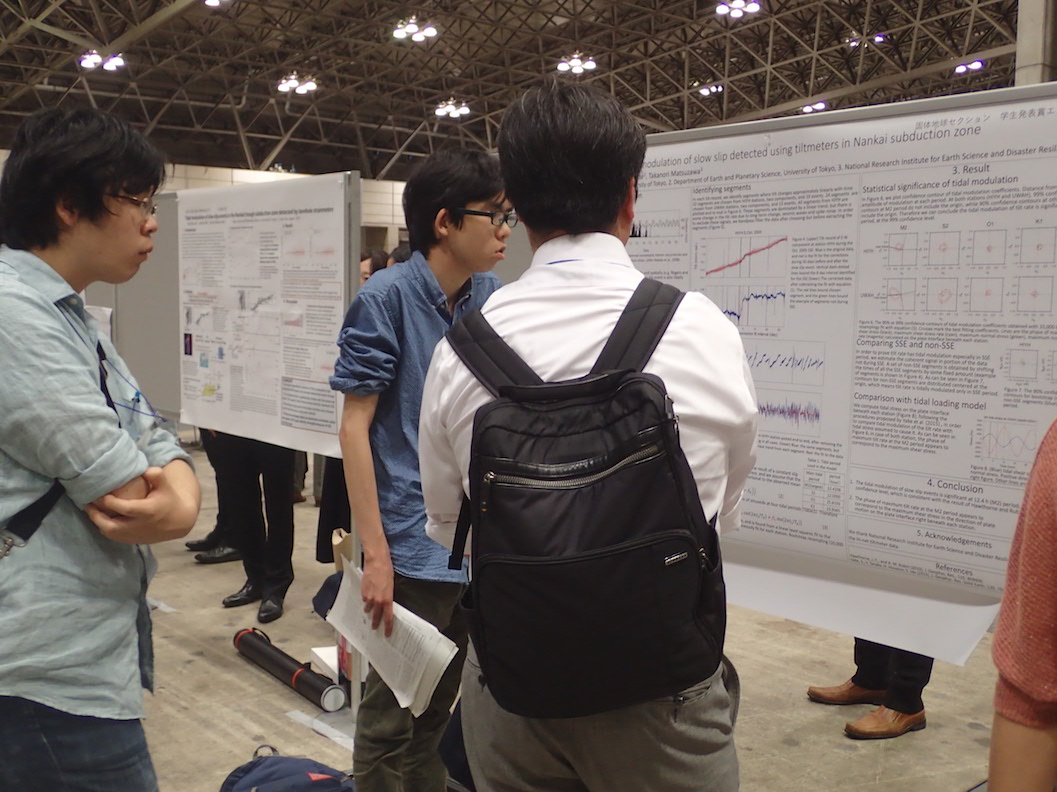
Apr.23-28, 2017
Related session at EGU General Assembly 2017 in Vienna, Austria
| Meeting | European Geoscience Union General Assembly 2017 (Official website) |
|---|---|
| Date | 2017/4/23-28 |
| Venue | Austria Center Vienna |
| Details | Slow Earthquakes-related session: SM2.2/EMRP4.13/GD5.8/NH4.13/TS5.7: Understanding large subduction earthquakes by integrating geological and geophysical observations, laboratory results, and numerical modeling (co-organized) Orals / Mon, 24 Apr, 13:30-17:00 / Room -0.96 Posters / Attendance Mon, 24 Apr, 17:30-19:00 / Hall X3 |
I attended to European Geosciences Union (EGU) General Assembly 2017 for the first time as a guest speaker invited by Dr. Jean-Pierre Vilotte of Institut de Physique du Globe de Paris (IPGP). The session "Understanding large subduction earthquakes by integrating geological and geophysical observations, laboratory results, and numerical modeling" was jointly held with the Tohoku earthquakes session. My lecture was based on the paper published in Science last year. Many members in our research area gave presentations based on observations in the coast of the Tohoku area. On the other hand, many speakers from Europe did presentations about modeling and experiments. 50 copies of our Newsletter Vol. 1 placed in the booth of the ERI run out on the first day. It suggests that certain number of researchers are interested in the Science of Slow Earthquakes.
Apr. 20, 2017
"Science of Slow Earthquakes" was introduced as a highlighted research in Handbook2017 of the Earthquake Research Institute, the University of Tokyo (p. 17).
Mar.17, 2017
Related symposium at annual meeting of the Physical Society of Japan (JPS)
URL : http://www.jps.or.jp/english/meetings-and-awards/meeting.html
Program (in Japanese) : http://w4.gakkai-web.net/jps_search/2017sp/data/html/program12.html
Feb.21-22, 2017
Groups C01/C02 joint workshop was held.
| Date | 2017/02/21-22 |
|---|---|
| Venue | Large conference room A, Kyushu University Nishijin Plaza |
| Program |
FEB 21
|
C01/C02 joint workshop was held on February 21-22 in Fukuoka city, Kyushu. The first workshop of C01 was co-hosted by C02, which is organizing various activities. We chose Fukuoka as a venue because Dr. Ahmed Elbanna of the University of Illinois whom we invited for our research field was staying at Kyushu University during that period.
The 2-day workshop consisted of the keynote lecture by Dr. Elbanna, lectures by 14 members of both C01 and C02 in English and active debates. There introduced leading-edge studies in approaches to slow earthquakes from different perspectives such as, tremor observation, mathematical models and large-scaled rock experiments.
Dr. Elbanna is a young and energetic researcher studying law of friction in granular materials. Although he has not mainly focused on slow earthquakes, his fundamental works have potential to provide better understanding of slow earthquakes. He said he got more interested in slow earthquakes during his stay in Japan this time. We hope we will have further cooperation.
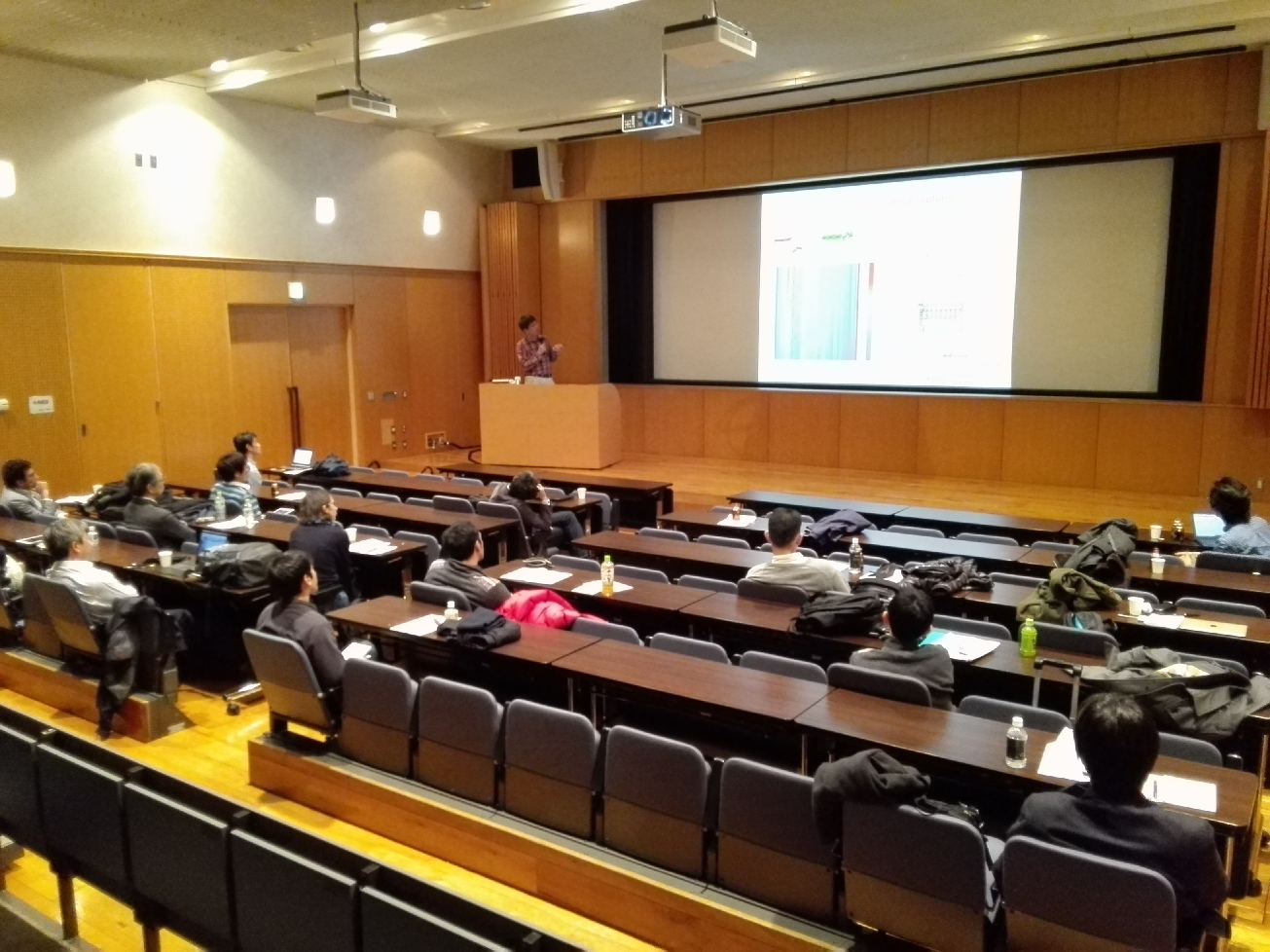
Jan.13, 2017
Observation groups workshop was held.
